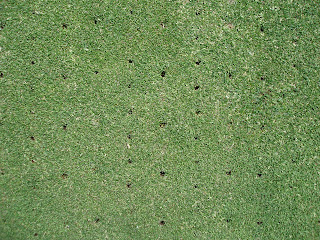Day One
We followed the same idea as last year and only required 3 guys to aerate the greens and pick the cores.

Cleaning Up Cores

Surface Immediately after
Aerating
The pattern we tried this time out was a tight 1.5" X 1.5" with an 3/8's - 3/4's cross tine set alternating with a 1/4 - 1/4 side eject set. With that combination of tines we pulled three 3/8's and four 1/4" cores and punched three 3/4 slices per holder for a total of forty-two holes and eighteen slices over the width of the aerator. Using an average size green at KGC and it works out to be 600,000 holes over the entire surface but because we used some cross tines (FYI cross tines just punch a hole in the shape of an X and don't remove any material) we really only pulled an average of 420,000 cores per green.
Day 2

2 Days After Aeration and
1 Day After Sand Top Dressing
We top dressed in two direction at a medium rate. I think that may have been a mistake since the larger holes may be too big to disappear in a timely fashion. My concern was adding too much sand and then end up stressing the greens while trying to incorporate/disperse the excess sand. We've done that before and that process comes with its own set of headaches.
Day 3
Day 2

2 Days After Aeration and
1 Day After Sand Top Dressing
We top dressed in two direction at a medium rate. I think that may have been a mistake since the larger holes may be too big to disappear in a timely fashion. My concern was adding too much sand and then end up stressing the greens while trying to incorporate/disperse the excess sand. We've done that before and that process comes with its own set of headaches.
Day 3
Day 4

Not really a whole lot different from the previous day. Although the weather was cool following aeration I don't really think that impacted recovery. The visible holes in the above picture are from the 3/8 's tines.
I guess good news is all the greens appear healthy and are growing. They are very soft not only from the aeration but also from all the extra water they are getting as we try to limit drought stress. We will have to top dress again but you won't notice. The mechanic, however, will since the reels will need extra sharpening this week. We will have play a bit with tine selection before our next aeration in the fall. We aerated the new putting green with all 3/8's on a 1.5"x1.5" spacing and it handled it not too bad. I know not every green on the course could handle that spacing but based on this aeration we may try using 1/4" tines on the 1.5"x1.5" spacing instead and see what comes of that.
I guess good news is all the greens appear healthy and are growing. They are very soft not only from the aeration but also from all the extra water they are getting as we try to limit drought stress. We will have to top dress again but you won't notice. The mechanic, however, will since the reels will need extra sharpening this week. We will have play a bit with tine selection before our next aeration in the fall. We aerated the new putting green with all 3/8's on a 1.5"x1.5" spacing and it handled it not too bad. I know not every green on the course could handle that spacing but based on this aeration we may try using 1/4" tines on the 1.5"x1.5" spacing instead and see what comes of that.











